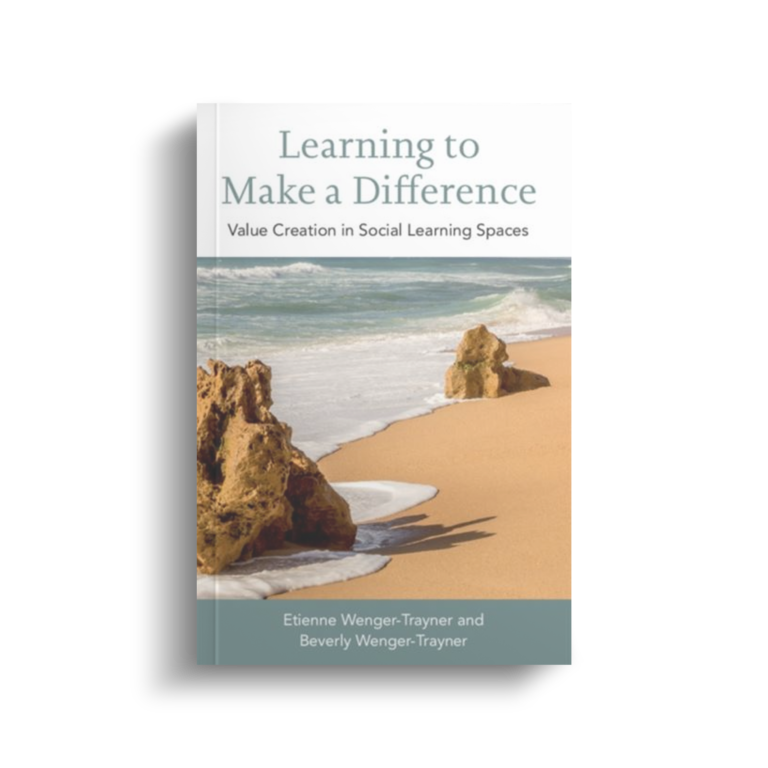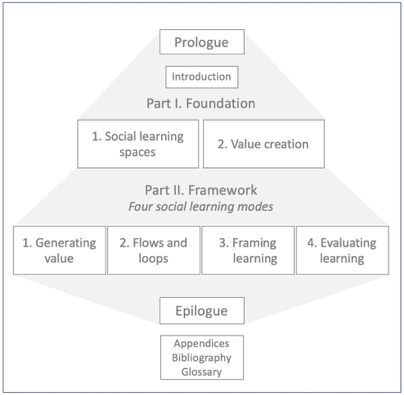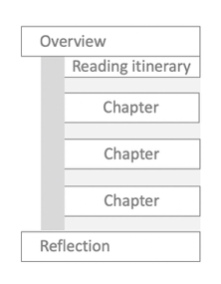Learning to make a difference
a new book series
hope for people who care to make a difference, with a practical and rigorous way to get there…
Learning to make a difference is a book series we started as an update our evolving social learning theory and its practical implications. It has been more than three decades since the concept of community of practice was introduced, and much has happened since then, both theoretically and practically.
We are planning three volumes. The first one, on value creation in social learning spaces, was published in 2020. The next two are in the works – on scaling up social learning in time and space and on the personal experience of being a learning agent. This will take a few years.
On this page, you will find the prologue for the series, in which we articulate the difference we care to make. You will also find the introduction to the first volume as well as its table of contents.
Volume 1
Wenger-Trayner, E., Wenger-Trayner, B. (2020). Learning to make a difference: value creation in social learning spaces. Cambridge University Press.
Prologue to the new series
The difference we care to make
We are social learning theorists and practitioners. Our theoretical perspectives have been adopted in many fields, sectors, and organizations. Over this time, they have also evolved through use and conceptual refinement. It is time to produce an updated statement—something we will do with a series of books.
We are calling this series Learning to make a difference. This is because we hope that our work will have this effect for those who use it. It is also because we are working on it while learning to make a difference ourselves. We are therefore using the expression in its double sense: learning in order to make a difference and learning how to make a difference.
We want to make learning front and center of public discourse. We want to shift how people think of learning. We want to rescue it from the backwaters. Many people we talk to associate learning with teaching or training, reading or searching the web: transmitting what is known from someone who knows to someone who doesn’t. But as important as it is to learn what is already known, this is not the main concern of our times. On its own, this kind of learning is not agile or imaginative enough to deal with the complex and fast-changing challenges of today. A learning theory for today should be addressing situations where there is some urgency to engage people who care to make a difference; what needs to be learned about making that difference is not yet known; knowing in practice involves being able to function productively under conditions of uncertainty; and earning depends on paying attention to how things play out.
We have both been involved in this enterprise for years, but through difference paths. Etienne has been working on social learning since he was invited to join the Institute for Research on Learning in Palo Alto in 1987, where he and Jean Lave started to write about communities of practice. Much of Beverly’s work has been in leading projects with a social-learning approach, even before she called it that. She has been an activist for equitable development, a consultant and facilitator in cross-national initiatives, and a researcher on practice-based pedagogy in higher education in Portugal. Since we became a team in work and life in 2008, the intersections of our interests have crystalized in this notion of learning to make a difference.
The joys and tribulations of working together create a synergy that keeps surprising us, generating insights and ideas that we would not have had on our own. After multiple iterations and refinements, these get channeled into our work and our writing. While we both continue to learn from each other, we also make distinct contributions to our joint writing. Etienne’s obsession with theoretical elegance and Bev’s commitment to feminism and global justice still remain salient in relation to each other. But they become impossible to disentangle once conversation upon conversation and draft after draft merge them into text.
This calls for a comment on the way we work. Our book is not an empirical study, our theory is not a claim to truth based on systematic data collection. It is the crafting of a language, a way of talking about learning that is meant to be useful. But it is not mere theoretical musing. It is anchored in our own experience of practice and that of people we work with. The resulting conceptual framework is both a theoretical perspective and a source of practical guidance.
We are not academic researchers in the traditional sense, but more something like practitioner-theorists. We welcome doing empirical work or participating in academic seminars when we have a chance. However, our main method consists in getting involved in practical social-learning projects.
We consider ourselves privileged. Our consulting, workshops, and retreats give us singular glimpses into distinct worlds in wide-ranging contexts, in different countries and across all sectors. We work with people—often underestimated by their organizations, but respected by those whose lives they enhance—who are doing extraordinary things in everyday situation. They are usually persistent, ambitious, and pragmatic all rolled into one, making tiny changes that add up to big ones and big changes that lead to a myriad of small ones.
Our clients don’t work with us because we build theories. They usually come to us because of our reputation for strategizing, facilitating, and evaluating social learning. But they are the people who, knowingly or not, help us develop the theory. How will our theory land with them and what they are doing? What further tools and language would be helpful? What are they doing that we haven’t thought of? What questions are they asking that our current framework does not cover? We are hungry to know. Practice is where we engage our uncertainties and test ideas; we learn by paying attention to the effect we have. We use this as a kind of theory-practice crucible. Trying to serve practice is the way we come up with theoretical insights, ideas, and concepts. We refine (or discard) them by testing what helps the people we work with make sense of their challenges and think about ways to address them.
All of these things—learning to make a difference, working in partnership with others, and paying attention to what happens to theory in practice— constitute our own social learning space. In-between projects writing is a luxury that we relish—and agonize over—as an integral part of that joint learning space. We live a self-referential loop: developing social learning theory by applying the theory to the development of the theory in practice.
While we keep a moderate tone in the book, we take advantage of the prologue to jump up and down and write in bright neon: we need a different learning theory for the 21st century—and it will have to be a social learning theory. We need to learn to live together on a small planet, where we don’t know what’s going to happen next and where the survival of our species appears to be at stake.
It’s 2020. There is political turmoil internationally. Tribalism is on the rise. All and nothing are on offer for a new generation. We can’t even guess what twists and turns are ahead, or if the ending is a happy or a tragic one. The clock is ticking. We need a theory, forged on the anvil of practice, that we can use to advance individuals, groups, communities, and organizations caring to make a difference.
In the subtitle of the book we refer to learning as creating value. As we explain in the final reflection in Part I, our theory refrains from defining in general what counts as value, as “the good,” or as “good” learning. This is something participants in social learning spaces have to decide. We as individuals, however, definitely have values. Our ethical stance is one that values diversity and dialogic respect. We work in service of a world where conditions are in place for all humans to flourish, and where flourishing includes having agency – the power to make a difference.
If you want to learn to make a difference, any difference, then this series is for you. You don’t have to agree with our values to find its perspective useful. You just need to care to make a difference, or care to enable others to make a difference. And whatever difference you care to make, we are eager to hear how you have used our work and the difference it has made.

Introduction to the first volume
Value creation in social learning spaces

In this first volume of our series, we lay a foundation to restate our social learning theory in terms of Learning to make a difference. To this end, we focus on a very specific dimension of the theory: social learning as a form of engagement with others. The notion of mutual engagement, central to social learning, has been part of the theory from the start, but it has been left undertheorized: the processes by which it becomes social learning have not be specified with enough rigor. This book addresses this weakness by developing a more detailed, operationalized view of the nature of mutual engagement in social learning. To this end, we introduce three new conceptual perspectives:
- Social learning spaces. This concept needs to be added to the theory because the processes we are theorizing in this book can be found in a wide range of contexts and social structures—not only in communities of practice, which have been the main social learning structure in the theory so far.
- Value creation. We develop this perspective on social learning and theorize it with a framework of types of value that allows us to take a deep dive into the details of how social learning contributes to the ability to make a difference.
- Social learning modes. The perspective of value creation allows us to specify four different modes through which participants in a social learning space create value.
We should state clearly up front that this work is a refinement and extension of the theory rather than a radical revision of it. For instance, the concept of community of practice is not displaced by that of social learning space. It remains a cornerstone of the theory, but with a clearer definition as we explain in Chapter 2. In subsequent volumes in this series, we will address and expand other aspects of the theory, including communities of practice, identity, boundaries, landscapes of practice, and others. Here we focus on making a difference via mutual engagement—theorized as value creation in social learning spaces. This general and operational perspective gives theoretical rigor to the notion of social learning. It also provides practical guidance for supporting different learning modes. We see this as a solid foundation to anchor, over the course of the series, a restatement of the entire theory in terms of learning to making a difference.
This book is a mix of theory and practice, which varies from chapter to chapter. We had multiple audiences in mind while we were writing: our clients, our colleagues, conveners and facilitators, evaluators, as well as theorists and researchers in a range of academic disciplines.
We obviously want our perspective on learning to be relevant to academics and scientists, teachers and trainers, as well as conveners and facilitators of social learning in various sectors. But we believe that it is also relevant to many people who may not think that enabling learning is central to their work. This includes activists and environmentalists; development workers and NGOs; managers at all levels of organizations across sectors; policymakers, politicians, and government officials, from local to international; healthcare practitioners and researchers; and many others. We realize that this represents a wide range of people who may not think they have much in common. But perhaps this is our offering: a common language to think in new ways about the relevance of social learning to their work.
We hope the book can be read fairly casually by those who just want to find a few useful ideas, selectively by those ready to jump into the weeds when something seems intriguing, and in depth by social learning wonks like us who want to explore every last corner.
We have structured the book to accommodate a wide range of readers and to make the text readable at several levels. We have kept the language mostly conversational. And we have woven in “lite” versions, to precede separate chapters that provide further details and formal rigor.
The prologue above is a personal commentary that situates this new series in its context: our life and work, our practice-based theory-building method, and the difference we hope to make by writing it.
The body of this first volume is divided into two parts. The chapters in each part are clustered in sections that cover one theme.
Part I presents our theoretical perspective in two sections. The first one introduces the concept of social learning space. The second one explores value creation as a perspective on social learning; it also introduces four social learning modes through which learning creates value: generating value, translating value into action, framing learning, and evaluating.
Part I stands on its own. Some readers only interested in our conceptual foundation may just want to read Part I.
Part II goes into further detail. It introduces our value-creation framework to operationalize the process of creating value in social learning spaces. It includes four sections that use the framework to explore the four social learning modes:
- eight value-creation cycles for generating value
- flows and loops to carry value to and from practice
- framing aspirations as a special form of learning
- evaluating as an integral part of social learning
We end the book with a short epilogue to contemplate where we think this is all going and what we will be writing next.
The six sections of the book have the same structure to support different levels of reading.
Each section starts with what we call an overview. Its purpose is to introduce the theme of the section as well as its main concepts. Hence the overview provides a reasonably complete summary of the key ideas; it could be all someone reads about that topic.
The overview ends with a reading itinerary to the contents of each chapter in that section. It will give the more selective reader a chance to decide what to read and what to skip. We also flag chapters that are more technical and contain long lists of details and examples. These lists are intended for the in-depth reader. Most are separated from the text into tables, so they are easier to skim or skip.
To keep the text uncluttered, we have confined our discussions of the academic literature and references to footnotes. These footnotes are numerous and sometimes quite long to satisfy the inquisitiveness of academically inclined readers.
Instead of a conclusion for each chapter, we end each section with a more substantial reflection. This way, the reader who skips chapters can still get a hold of our closing thoughts. Longer but less formal than a conclusion, the reflection is a place to comment on the significance of what was said, share our uncertainties and open questions, and make more personal observations.
We hope this introduction gives you a sense of both how this book fits in our overall scheme and how to read it to serve your specific purpose. And we hope you gain as much from reading it as we did writing it.
Prologue: the difference we care to make 1
Introduction: how to read this book 5
PART I FOUNDATION:
VALUE CREATION IN SOCIAL LEARNING SPACES
SECTION 1 SOCIAL LEARNING SPACES
1 Social learning spaces 17
2 What about communities of practice? 31
3 Social learning spaces and other structures 34
SECTION 2 VALUE CREATION: AGENCY AND SOCIAL LEARNING MODES
4 The perspective of value creation 47
5 Agency and social learning modes 59
PART II FRAMEWORK
SECTION 1 GENERATING VALUE: VALUE-CREATION CYCLES
6 Immediate and potential value 79
7 Applied and realized value 89
8 Enabling and strategic value 98
9 Orienting and transformative value 113
SECTION 2 TRANSLATING VALUE: FLOWS AND LOOPS
10 Flows into loops 133
11 Flows into other social learning spaces 143
SECTION 3 FRAMING: ASPIRATIONS AND UNCERTAINTIES
12 Framing participation 157
13 Framing value creation 167
14 Conducting a framing event 180
SECTION 4: EVALUATING: EFFECT AND CONTRIBUTION
15 Effect data: deriving and monitoring indicators 197
16 Contribution data: collecting value-creation stories 208
17 Consolidating and integrating the dataset 219
18 The art of making value visible 228
Epilogue: an ongoing journey 243
Appendix to Part II Section 2: Patterns of flows and loops 246
References 261
Index 270


Waves, sand, rocks: boundaries, change, resistance
by the ocean in Sesimbra, Portugal
home of our Social Learning Lab
